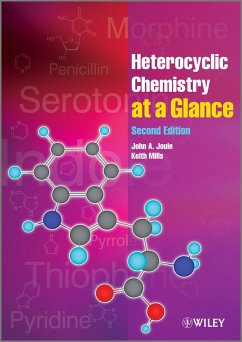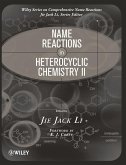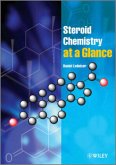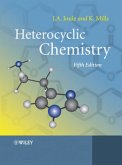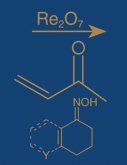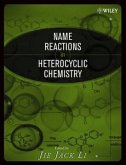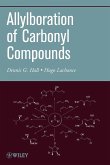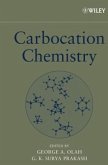- Broschiertes Buch
- Merkliste
- Auf die Merkliste
- Bewerten Bewerten
- Teilen
- Produkt teilen
- Produkterinnerung
- Produkterinnerung
This expanded second edition provides a concise overview of the main principles and reactions of heterocyclic chemistry for undergraduate students studying chemistry and related courses. Using a successful and student-friendly "at a glance" approach, this book helps the student grasp the essence of heterocyclic chemistry, ensuring that they can confidently use that knowledge when required. The chapters are thoroughly revised and updated with references to books and reviews; extra examples and student exercises with answers online; and color diagrams that emphasize exactly what is happening in the reaction chemistry depicted.…mehr
Andere Kunden interessierten sich auch für
![Name Heterocyclic 2 Name Heterocyclic 2]() Jie Jack LiName Heterocyclic 2182,99 €
Jie Jack LiName Heterocyclic 2182,99 €![Steroid Chemistry at a Glance Steroid Chemistry at a Glance]() Daniel LednicerSteroid Chemistry at a Glance52,99 €
Daniel LednicerSteroid Chemistry at a Glance52,99 €![Heterocyclic Chemistry Heterocyclic Chemistry]() John A. JouleHeterocyclic Chemistry65,99 €
John A. JouleHeterocyclic Chemistry65,99 €![Comprehensive Organic Name Reactions and Reagents, 3 Volume Set Comprehensive Organic Name Reactions and Reagents, 3 Volume Set]() Zerong WangComprehensive Organic Name Reactions and Reagents, 3 Volume Set789,99 €
Zerong WangComprehensive Organic Name Reactions and Reagents, 3 Volume Set789,99 €![Name Reactions Series Name Reactions Series]() Jie J. LiName Reactions Series906,99 €
Jie J. LiName Reactions Series906,99 €![Organic Reactions, Volume 73 Organic Reactions, Volume 73]() Dennis G. HallOrganic Reactions, Volume 7386,99 €
Dennis G. HallOrganic Reactions, Volume 7386,99 €![Carbocation Chemistry Carbocation Chemistry]() Carbocation Chemistry199,99 €
Carbocation Chemistry199,99 €-
-
-
This expanded second edition provides a concise overview of the main principles and reactions of heterocyclic chemistry for undergraduate students studying chemistry and related courses. Using a successful and student-friendly "at a glance" approach, this book helps the student grasp the essence of heterocyclic chemistry, ensuring that they can confidently use that knowledge when required. The chapters are thoroughly revised and updated with references to books and reviews; extra examples and student exercises with answers online; and color diagrams that emphasize exactly what is happening in the reaction chemistry depicted.
Hinweis: Dieser Artikel kann nur an eine deutsche Lieferadresse ausgeliefert werden.
Hinweis: Dieser Artikel kann nur an eine deutsche Lieferadresse ausgeliefert werden.
Produktdetails
- Produktdetails
- Chemistry At a Glance
- Verlag: Wiley & Sons
- Artikelnr. des Verlages: 14597121000
- 2. Aufl.
- Seitenzahl: 240
- Erscheinungstermin: 1. Oktober 2012
- Englisch
- Abmessung: 305mm x 212mm x 13mm
- Gewicht: 612g
- ISBN-13: 9780470971215
- ISBN-10: 0470971215
- Artikelnr.: 35677095
- Herstellerkennzeichnung
- Libri GmbH
- Europaallee 1
- 36244 Bad Hersfeld
- gpsr@libri.de
- Chemistry At a Glance
- Verlag: Wiley & Sons
- Artikelnr. des Verlages: 14597121000
- 2. Aufl.
- Seitenzahl: 240
- Erscheinungstermin: 1. Oktober 2012
- Englisch
- Abmessung: 305mm x 212mm x 13mm
- Gewicht: 612g
- ISBN-13: 9780470971215
- ISBN-10: 0470971215
- Artikelnr.: 35677095
- Herstellerkennzeichnung
- Libri GmbH
- Europaallee 1
- 36244 Bad Hersfeld
- gpsr@libri.de
Professor Emeritus John Joule, Chemistry Department, The University of Manchester, UK Professor Joule worked for 41 years at the University of Manchester before being appointed Professor Emeritus in 2004. Sabbatical periods were spent at the University of Ibadan, Nigeria, Johns Hopkins Medical School, Department of Pharmacology and Experimental Therapeutics, and the University of Maryland, Baltimore County. He was William Evans Visiting Fellow at Otago University, New Zealand. He has taught many courses on heterocyclic chemistry to industry and academe in the UK and elsewhere. He is currently Associate Editor for Tetrahedron Letters, Scientific Editor for Arkivoc, and Co-Editor of the annual Progress in Heterocyclic Chemistry . He is co-author with Keith Mills of the leading textbook in the field, Heterocyclic Chemistry (Wiley, 5th Edition 2010). Dr Keith Mills, Independent Consultant, UK Dr Mills worked in Medicinal Chemistry and Development Chemistry departments of GlaxoSmithKline for a total of 25 years. Since leaving GSK he has been an independent consultant to small pharmaceutical companies. Dr. Mills has worked in several areas of medicine and many areas of organic chemistry, but with particular emphasis on heterocyclic chemistry and the applications of transition metal-catalysed reactions. With John Joule he is co-author of the leading textbook in the field, Heterocyclic Chemistry (Wiley, 5th Edition 2010).
Biography v Abbreviations xii Introduction to Second Edition xiv 1. Heterocyclic Nomenclature 1 Six-membered aromatic heterocycles 2 Five-membered aromatic heterocycles 2 Non-aromatic heterocycles 3 Small-ring heterocycles 3 2. Structures of Heteroaromatic Compounds 4 Structures of benzene and naphthalene 4 Structures of pyridines and pyridiniums 5 Structures of quinolines and isoquinolines 6 Structures of diazines (illustrated using pyrimidine) 6 Structures of pyrroles, thiophenes and furans 6 Structure of indoles 8 Structures of azoles (illustrated using imidazole) 8 3. Common Reaction Types in Heterocyclic Chemistry 9 Introduction 9 Acidity and basicity 9 Electrophilic substitution of aromatic molecules 10 Nucleophilic substitution of aromatic molecules 13 Radical substitution of heterocycles 14 C-Metallated heterocycles as nucleophiles 15 Generation of C-metallated heterocycles 16 Dimethylformamide dimethyl acetal (DMFDMA) 17 Formation and hydrolysis of imine/enamine 18 Common synthetic equivalents of carbonyl compounds in ring synthesis 19 Cycloaddition reactions 19 4. Palladium in Heterocyclic Chemistry 21 Palladium(0)-catalysed (and related) reactions 21 Addition to alkenes: the Heck reaction 26 Carbonylation reactions 26 Cross-coupling reactions between heteroatom nucleophiles and halides - making carbon-heteroatom bonds 27 Triflates as substrates for palladium-catalysed reactions 27 Mechanisms of palladium(0)-catalysed processes 28 Reactions involving electrophilic palladation 29 Copper-catalysed amination 30 Selectivity 31 5. Pyridines 33 Electrophilic addition to nitrogen 33 Electrophilic substitution at carbon 34 Nucleophilic substitution 35 Nucleophilic addition to pyridinium salts 36 C-metallated pyridines 37 Palladium(0)-catalysed reactions 39 Oxidation and reduction 39 Pericyclic reactions 40 Alkyl and carboxylic acid substituents 40 Oxygen substituents 41 N-Oxides 42 Amine substituents 43 Ring synthesis - disconnections 43 Synthesis of pyridines from 1,5-dicarbonyl compounds 44 Synthesis of pyridines from an aldehyde, two equivalents of a 1,3-dicarbonyl compound and ammonia 45 Synthesis of pyridines from 1,3-dicarbonyl compounds and a C2N unit 45 Exercises 47 6. Diazines 48 Electrophilic addition to nitrogen 49 Electrophilic substitution at carbon 49 Nucleophilic substitution 50 Radical substitution 52 C-Metallated diazines 52 Palladium(0)-catalysed reactions 53 Pericyclic reactions 54 Oxygen substituents 55 N-Oxides 57 Amine substituents 57 Ring synthesis - disconnections 58 Synthesis of pyridazines from 1,4-dicarbonyl compounds 58 Synthesis of pyrimidines from 1,3-dicarbonyl compounds 58 Synthesis of pyrazines from 1,2-dicarbonyl compounds 59 Synthesis of pyrazines from
-amino-carbonyl compounds 60 Benzodiazines 60 Exercises 61 7. Quinolines and Isoquinolines 62 Electrophilic addition to nitrogen 62 Electrophilic substitution at carbon 62 Nucleophilic substitution 63 Nucleophilic addition to quinolinium/isoquinolinium salts 64 C-Metallated quinolines and isoquinolines 65 Palladium(0)-catalysed reactions 65 Oxidation and reduction 66 Alkyl substituents 66 Oxygen substituents 67 N-Oxides 67 Ring synthesis - disconnections 67 Synthesis of quinolines from anilines 67 Synthesis of quinolines from ortho-aminoaryl ketones or aldehydes 68 Synthesis of isoquinolines from 2-arylethamines 69 Synthesis of isoquinolines from aryl-aldehydes and an aminoacetaldehyde acetal 69 Synthesis of isoquinolines from ortho-alkynyl aryl-aldehydes or corresponding imines 70 Exercises 70 8. Pyryliums, Benzopyryliums, Pyrones and Benzopyrones 71 Pyrylium salts 71 Electrophiles 71 Nucleophilic addition 71 Ring-opening reactions of 2H-pyrans 71 Oxygen substituents - pyrones and benzopyrones 73 Ring synthesis of pyryliums from 1,5-diketones 74 Ring synthesis of 4-pyrones from 1,3,5-triketones 75 Ring synthesis of 2-pyrones from 1,3-keto-aldehydes 75 Ring synthesis of 1-benzopyryliums, coumarins and chromones 76 Exercises 77 9. Pyrroles 78 Electrophilic substitution at carbon 78 N-Deprotonation and N-metallated pyrroles 80 C-Metallated pyrroles 80 Palladium(0)-catalysed reactions 81 Oxidation and reduction 81 Pericyclic reactions 82 Reactivity of side-chain substituents 82 The 'pigments of life' 82 Ring synthesis - disconnections 83 Synthesis of pyrroles from 1,4-dicarbonyl compounds 83 Synthesis of pyrroles from
-amino-ketones 83 Synthesis of pyrroles using isocyanides 84 Exercises 85 10. Indoles 86 Electrophilic substitution at carbon 86 N-Deprotonation and N-metallated indoles 89 C-Metallated indoles 90 Palladium(0)-catalysed reactions 91 Oxidation and reduction 92 Pericyclic reactions 92 Reactivity of side-chain substituents 93 Oxygen substituents 94 Ring synthesis - disconnections 94 Synthesis of indoles from arylhydrazones 94 Synthesis of indoles from ortho-nitrotoluenes 95 Synthesis of indoles from ortho-aminoaryl alkynes 96 Synthesis of indoles from ortho-alkylaryl isocyanides 96 Synthesis of indoles from ortho-acyl anilides 96 Synthesis of isatins from anilines 97 Synthesis of oxindoles from anilines 97 Synthesis of indoxyls from anthranilic acids 97 Azaindoles 97 Exercises 98 11. Furans and Thiophenes 99 Electrophilic substitution at carbon 99 C-Metallated thiophenes and furans 101 Palladium(0)-catalysed reactions 102 Oxidation and reduction 102 Pericyclic reactions 103 Oxygen substituents 104 Ring synthesis - disconnections 105 Synthesis of furans and thiophenes from 1,4-dicarbonyl compounds 105 Exercises 106 12. 1,2-Azoles and 1,3-Azoles 107 Introduction 107 Electrophilic addition to N 107 Electrophilic substitution at C 109 Nucleophilic substitution of halogen 110 N-Deprotonation and N-metallated imidazoles and pyrazoles 110 C-Metallated N-substituted imidazoles and pyrazoles, and C-metallated thiazoles and isothiazoles 111 C-Deprotonation of oxazoles and isoxazoles 112 Palladium(0)-catalysed reactions 113 1,3-Azolium ylides 113 Reductions 114 Pericyclic reactions 114 Oxygen and amine substituents 115 1,3-Azoles ring synthesis - disconnections 116 Synthesis of thiazoles and imidazoles from
-halo-ketones 116 Synthesis of 1,3-azoles from 1,4-dicarbonyl compounds 117 Synthesis of 1,3-azoles using tosylmethyl isocyanide 118 Synthesis of 1,3-azoles via dehydrogenation 118 1,2-Azoles ring synthesis - disconnections 119 Synthesis of pyrazoles and isoxazoles from 1,3-dicarbonyl compounds 119 Synthesis of isoxazoles and pyrazoles from alkynes 120 Synthesis of isothiazoles from
-amino
,ß-unsaturated carbonyl compounds 121 Exercises 121 13. Purines 122 Electrophilic addition to nitrogen 124 Electrophilic substitution at carbon 125 N-Deprotonation and N-metallated purines 125 Oxidation 126 Nucleophilic substitution 126 C-Metallated purines by direct deprotonation or halogen-metal exchange 128 Palladium(0)-catalysed reactions 128 Purines with oxygen and amine substituents 128 Ring synthesis - disconnections 130 Synthesis of purines from 4,5-diaminopyrimidines 130 Synthesis of purines from 5-aminoimidazole-4-carboxamide 131 'One-step syntheses' 131 Exercises 131 14. Heterocycles with More than Two Heteroatoms: Higher Azoles (5-Membered) and Higher Azines (6-Membered) 132 Higher Azoles 132 Introduction 132 Higher azoles containing nitrogen as the only ring heteroatom: triazoles, tetrazole and pentazole 132 Benzotriazole 136 Higher azoles also containing ring sulfur or oxygen: oxa- and thiadiazoles 137 Higher azines 139 Exercises 142 15. Heterocycles with Ring-Junction Nitrogen (Bridgehead Nitrogen) 143 Introduction 143 Indolizine 144 Azaindolizines 144 Synthesis of indolizines and azaindolizines 146 Quinoliziniums and quinolizinones 147 Heteropyrrolizines (pyrrolizines containing additional heteroatoms) 148 Cyclazines 148 Exercises 149 16. Non-Aromatic Heterocycles 150 Introduction 150 Three-membered rings 150 Four-membered rings 153 Five- and six-membered rings 153 Ring synthesis 155 17. Heterocycles in Nature 158 Heterocyclic
-amino acids and related substances 158 Heterocyclic vitamins - co-enzymes 159 Porphobilinogen and the 'Pigments of Life' 162 Deoxyribonucleic acid (DNA), the store of genetic information, and ribonucleic acid (RNA), its deliverer 163 Heterocyclic secondary metabolites 165 18. Heterocycles in Medicine 167 Medicinal chemistry - how drugs function 167 Drug discovery 168 Drug development 169 The neurotransmitters 169 Histamine 170 Acetylcholine (ACh) 171 Anticholinesterase agents 172 5-Hydroxytryptamine (5-HT) (serotonin) 172 Adrenaline and noradrenaline 173 Other significant cardiovascular drugs 173 Drugs acting specifically on the CNS 173 Other enzyme inhibitors 174 Anti-infective agents 175 Antiparasitic drugs 175 Antibacterial drugs 176 Antiviral drugs 177 Anticancer drugs 177 Photochemotherapy 178 19. Applications and Occurrences of Heterocycles in Everyday Life 180 Introduction 180 Dyes and pigments 180 Polymers 181 Pesticides 182 Explosives 184 Food and drink 186 Heterocyclic chemistry of cooking 187 Natural and synthetic food colours 190 Flavours and fragrances (F&F) 190 Toxins 192 Electrical and electronic 193 Index 195
-amino-carbonyl compounds 60 Benzodiazines 60 Exercises 61 7. Quinolines and Isoquinolines 62 Electrophilic addition to nitrogen 62 Electrophilic substitution at carbon 62 Nucleophilic substitution 63 Nucleophilic addition to quinolinium/isoquinolinium salts 64 C-Metallated quinolines and isoquinolines 65 Palladium(0)-catalysed reactions 65 Oxidation and reduction 66 Alkyl substituents 66 Oxygen substituents 67 N-Oxides 67 Ring synthesis - disconnections 67 Synthesis of quinolines from anilines 67 Synthesis of quinolines from ortho-aminoaryl ketones or aldehydes 68 Synthesis of isoquinolines from 2-arylethamines 69 Synthesis of isoquinolines from aryl-aldehydes and an aminoacetaldehyde acetal 69 Synthesis of isoquinolines from ortho-alkynyl aryl-aldehydes or corresponding imines 70 Exercises 70 8. Pyryliums, Benzopyryliums, Pyrones and Benzopyrones 71 Pyrylium salts 71 Electrophiles 71 Nucleophilic addition 71 Ring-opening reactions of 2H-pyrans 71 Oxygen substituents - pyrones and benzopyrones 73 Ring synthesis of pyryliums from 1,5-diketones 74 Ring synthesis of 4-pyrones from 1,3,5-triketones 75 Ring synthesis of 2-pyrones from 1,3-keto-aldehydes 75 Ring synthesis of 1-benzopyryliums, coumarins and chromones 76 Exercises 77 9. Pyrroles 78 Electrophilic substitution at carbon 78 N-Deprotonation and N-metallated pyrroles 80 C-Metallated pyrroles 80 Palladium(0)-catalysed reactions 81 Oxidation and reduction 81 Pericyclic reactions 82 Reactivity of side-chain substituents 82 The 'pigments of life' 82 Ring synthesis - disconnections 83 Synthesis of pyrroles from 1,4-dicarbonyl compounds 83 Synthesis of pyrroles from
-amino-ketones 83 Synthesis of pyrroles using isocyanides 84 Exercises 85 10. Indoles 86 Electrophilic substitution at carbon 86 N-Deprotonation and N-metallated indoles 89 C-Metallated indoles 90 Palladium(0)-catalysed reactions 91 Oxidation and reduction 92 Pericyclic reactions 92 Reactivity of side-chain substituents 93 Oxygen substituents 94 Ring synthesis - disconnections 94 Synthesis of indoles from arylhydrazones 94 Synthesis of indoles from ortho-nitrotoluenes 95 Synthesis of indoles from ortho-aminoaryl alkynes 96 Synthesis of indoles from ortho-alkylaryl isocyanides 96 Synthesis of indoles from ortho-acyl anilides 96 Synthesis of isatins from anilines 97 Synthesis of oxindoles from anilines 97 Synthesis of indoxyls from anthranilic acids 97 Azaindoles 97 Exercises 98 11. Furans and Thiophenes 99 Electrophilic substitution at carbon 99 C-Metallated thiophenes and furans 101 Palladium(0)-catalysed reactions 102 Oxidation and reduction 102 Pericyclic reactions 103 Oxygen substituents 104 Ring synthesis - disconnections 105 Synthesis of furans and thiophenes from 1,4-dicarbonyl compounds 105 Exercises 106 12. 1,2-Azoles and 1,3-Azoles 107 Introduction 107 Electrophilic addition to N 107 Electrophilic substitution at C 109 Nucleophilic substitution of halogen 110 N-Deprotonation and N-metallated imidazoles and pyrazoles 110 C-Metallated N-substituted imidazoles and pyrazoles, and C-metallated thiazoles and isothiazoles 111 C-Deprotonation of oxazoles and isoxazoles 112 Palladium(0)-catalysed reactions 113 1,3-Azolium ylides 113 Reductions 114 Pericyclic reactions 114 Oxygen and amine substituents 115 1,3-Azoles ring synthesis - disconnections 116 Synthesis of thiazoles and imidazoles from
-halo-ketones 116 Synthesis of 1,3-azoles from 1,4-dicarbonyl compounds 117 Synthesis of 1,3-azoles using tosylmethyl isocyanide 118 Synthesis of 1,3-azoles via dehydrogenation 118 1,2-Azoles ring synthesis - disconnections 119 Synthesis of pyrazoles and isoxazoles from 1,3-dicarbonyl compounds 119 Synthesis of isoxazoles and pyrazoles from alkynes 120 Synthesis of isothiazoles from
-amino
,ß-unsaturated carbonyl compounds 121 Exercises 121 13. Purines 122 Electrophilic addition to nitrogen 124 Electrophilic substitution at carbon 125 N-Deprotonation and N-metallated purines 125 Oxidation 126 Nucleophilic substitution 126 C-Metallated purines by direct deprotonation or halogen-metal exchange 128 Palladium(0)-catalysed reactions 128 Purines with oxygen and amine substituents 128 Ring synthesis - disconnections 130 Synthesis of purines from 4,5-diaminopyrimidines 130 Synthesis of purines from 5-aminoimidazole-4-carboxamide 131 'One-step syntheses' 131 Exercises 131 14. Heterocycles with More than Two Heteroatoms: Higher Azoles (5-Membered) and Higher Azines (6-Membered) 132 Higher Azoles 132 Introduction 132 Higher azoles containing nitrogen as the only ring heteroatom: triazoles, tetrazole and pentazole 132 Benzotriazole 136 Higher azoles also containing ring sulfur or oxygen: oxa- and thiadiazoles 137 Higher azines 139 Exercises 142 15. Heterocycles with Ring-Junction Nitrogen (Bridgehead Nitrogen) 143 Introduction 143 Indolizine 144 Azaindolizines 144 Synthesis of indolizines and azaindolizines 146 Quinoliziniums and quinolizinones 147 Heteropyrrolizines (pyrrolizines containing additional heteroatoms) 148 Cyclazines 148 Exercises 149 16. Non-Aromatic Heterocycles 150 Introduction 150 Three-membered rings 150 Four-membered rings 153 Five- and six-membered rings 153 Ring synthesis 155 17. Heterocycles in Nature 158 Heterocyclic
-amino acids and related substances 158 Heterocyclic vitamins - co-enzymes 159 Porphobilinogen and the 'Pigments of Life' 162 Deoxyribonucleic acid (DNA), the store of genetic information, and ribonucleic acid (RNA), its deliverer 163 Heterocyclic secondary metabolites 165 18. Heterocycles in Medicine 167 Medicinal chemistry - how drugs function 167 Drug discovery 168 Drug development 169 The neurotransmitters 169 Histamine 170 Acetylcholine (ACh) 171 Anticholinesterase agents 172 5-Hydroxytryptamine (5-HT) (serotonin) 172 Adrenaline and noradrenaline 173 Other significant cardiovascular drugs 173 Drugs acting specifically on the CNS 173 Other enzyme inhibitors 174 Anti-infective agents 175 Antiparasitic drugs 175 Antibacterial drugs 176 Antiviral drugs 177 Anticancer drugs 177 Photochemotherapy 178 19. Applications and Occurrences of Heterocycles in Everyday Life 180 Introduction 180 Dyes and pigments 180 Polymers 181 Pesticides 182 Explosives 184 Food and drink 186 Heterocyclic chemistry of cooking 187 Natural and synthetic food colours 190 Flavours and fragrances (F&F) 190 Toxins 192 Electrical and electronic 193 Index 195
Biography v Abbreviations xii Introduction to Second Edition xiv 1. Heterocyclic Nomenclature 1 Six-membered aromatic heterocycles 2 Five-membered aromatic heterocycles 2 Non-aromatic heterocycles 3 Small-ring heterocycles 3 2. Structures of Heteroaromatic Compounds 4 Structures of benzene and naphthalene 4 Structures of pyridines and pyridiniums 5 Structures of quinolines and isoquinolines 6 Structures of diazines (illustrated using pyrimidine) 6 Structures of pyrroles, thiophenes and furans 6 Structure of indoles 8 Structures of azoles (illustrated using imidazole) 8 3. Common Reaction Types in Heterocyclic Chemistry 9 Introduction 9 Acidity and basicity 9 Electrophilic substitution of aromatic molecules 10 Nucleophilic substitution of aromatic molecules 13 Radical substitution of heterocycles 14 C-Metallated heterocycles as nucleophiles 15 Generation of C-metallated heterocycles 16 Dimethylformamide dimethyl acetal (DMFDMA) 17 Formation and hydrolysis of imine/enamine 18 Common synthetic equivalents of carbonyl compounds in ring synthesis 19 Cycloaddition reactions 19 4. Palladium in Heterocyclic Chemistry 21 Palladium(0)-catalysed (and related) reactions 21 Addition to alkenes: the Heck reaction 26 Carbonylation reactions 26 Cross-coupling reactions between heteroatom nucleophiles and halides - making carbon-heteroatom bonds 27 Triflates as substrates for palladium-catalysed reactions 27 Mechanisms of palladium(0)-catalysed processes 28 Reactions involving electrophilic palladation 29 Copper-catalysed amination 30 Selectivity 31 5. Pyridines 33 Electrophilic addition to nitrogen 33 Electrophilic substitution at carbon 34 Nucleophilic substitution 35 Nucleophilic addition to pyridinium salts 36 C-metallated pyridines 37 Palladium(0)-catalysed reactions 39 Oxidation and reduction 39 Pericyclic reactions 40 Alkyl and carboxylic acid substituents 40 Oxygen substituents 41 N-Oxides 42 Amine substituents 43 Ring synthesis - disconnections 43 Synthesis of pyridines from 1,5-dicarbonyl compounds 44 Synthesis of pyridines from an aldehyde, two equivalents of a 1,3-dicarbonyl compound and ammonia 45 Synthesis of pyridines from 1,3-dicarbonyl compounds and a C2N unit 45 Exercises 47 6. Diazines 48 Electrophilic addition to nitrogen 49 Electrophilic substitution at carbon 49 Nucleophilic substitution 50 Radical substitution 52 C-Metallated diazines 52 Palladium(0)-catalysed reactions 53 Pericyclic reactions 54 Oxygen substituents 55 N-Oxides 57 Amine substituents 57 Ring synthesis - disconnections 58 Synthesis of pyridazines from 1,4-dicarbonyl compounds 58 Synthesis of pyrimidines from 1,3-dicarbonyl compounds 58 Synthesis of pyrazines from 1,2-dicarbonyl compounds 59 Synthesis of pyrazines from
-amino-carbonyl compounds 60 Benzodiazines 60 Exercises 61 7. Quinolines and Isoquinolines 62 Electrophilic addition to nitrogen 62 Electrophilic substitution at carbon 62 Nucleophilic substitution 63 Nucleophilic addition to quinolinium/isoquinolinium salts 64 C-Metallated quinolines and isoquinolines 65 Palladium(0)-catalysed reactions 65 Oxidation and reduction 66 Alkyl substituents 66 Oxygen substituents 67 N-Oxides 67 Ring synthesis - disconnections 67 Synthesis of quinolines from anilines 67 Synthesis of quinolines from ortho-aminoaryl ketones or aldehydes 68 Synthesis of isoquinolines from 2-arylethamines 69 Synthesis of isoquinolines from aryl-aldehydes and an aminoacetaldehyde acetal 69 Synthesis of isoquinolines from ortho-alkynyl aryl-aldehydes or corresponding imines 70 Exercises 70 8. Pyryliums, Benzopyryliums, Pyrones and Benzopyrones 71 Pyrylium salts 71 Electrophiles 71 Nucleophilic addition 71 Ring-opening reactions of 2H-pyrans 71 Oxygen substituents - pyrones and benzopyrones 73 Ring synthesis of pyryliums from 1,5-diketones 74 Ring synthesis of 4-pyrones from 1,3,5-triketones 75 Ring synthesis of 2-pyrones from 1,3-keto-aldehydes 75 Ring synthesis of 1-benzopyryliums, coumarins and chromones 76 Exercises 77 9. Pyrroles 78 Electrophilic substitution at carbon 78 N-Deprotonation and N-metallated pyrroles 80 C-Metallated pyrroles 80 Palladium(0)-catalysed reactions 81 Oxidation and reduction 81 Pericyclic reactions 82 Reactivity of side-chain substituents 82 The 'pigments of life' 82 Ring synthesis - disconnections 83 Synthesis of pyrroles from 1,4-dicarbonyl compounds 83 Synthesis of pyrroles from
-amino-ketones 83 Synthesis of pyrroles using isocyanides 84 Exercises 85 10. Indoles 86 Electrophilic substitution at carbon 86 N-Deprotonation and N-metallated indoles 89 C-Metallated indoles 90 Palladium(0)-catalysed reactions 91 Oxidation and reduction 92 Pericyclic reactions 92 Reactivity of side-chain substituents 93 Oxygen substituents 94 Ring synthesis - disconnections 94 Synthesis of indoles from arylhydrazones 94 Synthesis of indoles from ortho-nitrotoluenes 95 Synthesis of indoles from ortho-aminoaryl alkynes 96 Synthesis of indoles from ortho-alkylaryl isocyanides 96 Synthesis of indoles from ortho-acyl anilides 96 Synthesis of isatins from anilines 97 Synthesis of oxindoles from anilines 97 Synthesis of indoxyls from anthranilic acids 97 Azaindoles 97 Exercises 98 11. Furans and Thiophenes 99 Electrophilic substitution at carbon 99 C-Metallated thiophenes and furans 101 Palladium(0)-catalysed reactions 102 Oxidation and reduction 102 Pericyclic reactions 103 Oxygen substituents 104 Ring synthesis - disconnections 105 Synthesis of furans and thiophenes from 1,4-dicarbonyl compounds 105 Exercises 106 12. 1,2-Azoles and 1,3-Azoles 107 Introduction 107 Electrophilic addition to N 107 Electrophilic substitution at C 109 Nucleophilic substitution of halogen 110 N-Deprotonation and N-metallated imidazoles and pyrazoles 110 C-Metallated N-substituted imidazoles and pyrazoles, and C-metallated thiazoles and isothiazoles 111 C-Deprotonation of oxazoles and isoxazoles 112 Palladium(0)-catalysed reactions 113 1,3-Azolium ylides 113 Reductions 114 Pericyclic reactions 114 Oxygen and amine substituents 115 1,3-Azoles ring synthesis - disconnections 116 Synthesis of thiazoles and imidazoles from
-halo-ketones 116 Synthesis of 1,3-azoles from 1,4-dicarbonyl compounds 117 Synthesis of 1,3-azoles using tosylmethyl isocyanide 118 Synthesis of 1,3-azoles via dehydrogenation 118 1,2-Azoles ring synthesis - disconnections 119 Synthesis of pyrazoles and isoxazoles from 1,3-dicarbonyl compounds 119 Synthesis of isoxazoles and pyrazoles from alkynes 120 Synthesis of isothiazoles from
-amino
,ß-unsaturated carbonyl compounds 121 Exercises 121 13. Purines 122 Electrophilic addition to nitrogen 124 Electrophilic substitution at carbon 125 N-Deprotonation and N-metallated purines 125 Oxidation 126 Nucleophilic substitution 126 C-Metallated purines by direct deprotonation or halogen-metal exchange 128 Palladium(0)-catalysed reactions 128 Purines with oxygen and amine substituents 128 Ring synthesis - disconnections 130 Synthesis of purines from 4,5-diaminopyrimidines 130 Synthesis of purines from 5-aminoimidazole-4-carboxamide 131 'One-step syntheses' 131 Exercises 131 14. Heterocycles with More than Two Heteroatoms: Higher Azoles (5-Membered) and Higher Azines (6-Membered) 132 Higher Azoles 132 Introduction 132 Higher azoles containing nitrogen as the only ring heteroatom: triazoles, tetrazole and pentazole 132 Benzotriazole 136 Higher azoles also containing ring sulfur or oxygen: oxa- and thiadiazoles 137 Higher azines 139 Exercises 142 15. Heterocycles with Ring-Junction Nitrogen (Bridgehead Nitrogen) 143 Introduction 143 Indolizine 144 Azaindolizines 144 Synthesis of indolizines and azaindolizines 146 Quinoliziniums and quinolizinones 147 Heteropyrrolizines (pyrrolizines containing additional heteroatoms) 148 Cyclazines 148 Exercises 149 16. Non-Aromatic Heterocycles 150 Introduction 150 Three-membered rings 150 Four-membered rings 153 Five- and six-membered rings 153 Ring synthesis 155 17. Heterocycles in Nature 158 Heterocyclic
-amino acids and related substances 158 Heterocyclic vitamins - co-enzymes 159 Porphobilinogen and the 'Pigments of Life' 162 Deoxyribonucleic acid (DNA), the store of genetic information, and ribonucleic acid (RNA), its deliverer 163 Heterocyclic secondary metabolites 165 18. Heterocycles in Medicine 167 Medicinal chemistry - how drugs function 167 Drug discovery 168 Drug development 169 The neurotransmitters 169 Histamine 170 Acetylcholine (ACh) 171 Anticholinesterase agents 172 5-Hydroxytryptamine (5-HT) (serotonin) 172 Adrenaline and noradrenaline 173 Other significant cardiovascular drugs 173 Drugs acting specifically on the CNS 173 Other enzyme inhibitors 174 Anti-infective agents 175 Antiparasitic drugs 175 Antibacterial drugs 176 Antiviral drugs 177 Anticancer drugs 177 Photochemotherapy 178 19. Applications and Occurrences of Heterocycles in Everyday Life 180 Introduction 180 Dyes and pigments 180 Polymers 181 Pesticides 182 Explosives 184 Food and drink 186 Heterocyclic chemistry of cooking 187 Natural and synthetic food colours 190 Flavours and fragrances (F&F) 190 Toxins 192 Electrical and electronic 193 Index 195
-amino-carbonyl compounds 60 Benzodiazines 60 Exercises 61 7. Quinolines and Isoquinolines 62 Electrophilic addition to nitrogen 62 Electrophilic substitution at carbon 62 Nucleophilic substitution 63 Nucleophilic addition to quinolinium/isoquinolinium salts 64 C-Metallated quinolines and isoquinolines 65 Palladium(0)-catalysed reactions 65 Oxidation and reduction 66 Alkyl substituents 66 Oxygen substituents 67 N-Oxides 67 Ring synthesis - disconnections 67 Synthesis of quinolines from anilines 67 Synthesis of quinolines from ortho-aminoaryl ketones or aldehydes 68 Synthesis of isoquinolines from 2-arylethamines 69 Synthesis of isoquinolines from aryl-aldehydes and an aminoacetaldehyde acetal 69 Synthesis of isoquinolines from ortho-alkynyl aryl-aldehydes or corresponding imines 70 Exercises 70 8. Pyryliums, Benzopyryliums, Pyrones and Benzopyrones 71 Pyrylium salts 71 Electrophiles 71 Nucleophilic addition 71 Ring-opening reactions of 2H-pyrans 71 Oxygen substituents - pyrones and benzopyrones 73 Ring synthesis of pyryliums from 1,5-diketones 74 Ring synthesis of 4-pyrones from 1,3,5-triketones 75 Ring synthesis of 2-pyrones from 1,3-keto-aldehydes 75 Ring synthesis of 1-benzopyryliums, coumarins and chromones 76 Exercises 77 9. Pyrroles 78 Electrophilic substitution at carbon 78 N-Deprotonation and N-metallated pyrroles 80 C-Metallated pyrroles 80 Palladium(0)-catalysed reactions 81 Oxidation and reduction 81 Pericyclic reactions 82 Reactivity of side-chain substituents 82 The 'pigments of life' 82 Ring synthesis - disconnections 83 Synthesis of pyrroles from 1,4-dicarbonyl compounds 83 Synthesis of pyrroles from
-amino-ketones 83 Synthesis of pyrroles using isocyanides 84 Exercises 85 10. Indoles 86 Electrophilic substitution at carbon 86 N-Deprotonation and N-metallated indoles 89 C-Metallated indoles 90 Palladium(0)-catalysed reactions 91 Oxidation and reduction 92 Pericyclic reactions 92 Reactivity of side-chain substituents 93 Oxygen substituents 94 Ring synthesis - disconnections 94 Synthesis of indoles from arylhydrazones 94 Synthesis of indoles from ortho-nitrotoluenes 95 Synthesis of indoles from ortho-aminoaryl alkynes 96 Synthesis of indoles from ortho-alkylaryl isocyanides 96 Synthesis of indoles from ortho-acyl anilides 96 Synthesis of isatins from anilines 97 Synthesis of oxindoles from anilines 97 Synthesis of indoxyls from anthranilic acids 97 Azaindoles 97 Exercises 98 11. Furans and Thiophenes 99 Electrophilic substitution at carbon 99 C-Metallated thiophenes and furans 101 Palladium(0)-catalysed reactions 102 Oxidation and reduction 102 Pericyclic reactions 103 Oxygen substituents 104 Ring synthesis - disconnections 105 Synthesis of furans and thiophenes from 1,4-dicarbonyl compounds 105 Exercises 106 12. 1,2-Azoles and 1,3-Azoles 107 Introduction 107 Electrophilic addition to N 107 Electrophilic substitution at C 109 Nucleophilic substitution of halogen 110 N-Deprotonation and N-metallated imidazoles and pyrazoles 110 C-Metallated N-substituted imidazoles and pyrazoles, and C-metallated thiazoles and isothiazoles 111 C-Deprotonation of oxazoles and isoxazoles 112 Palladium(0)-catalysed reactions 113 1,3-Azolium ylides 113 Reductions 114 Pericyclic reactions 114 Oxygen and amine substituents 115 1,3-Azoles ring synthesis - disconnections 116 Synthesis of thiazoles and imidazoles from
-halo-ketones 116 Synthesis of 1,3-azoles from 1,4-dicarbonyl compounds 117 Synthesis of 1,3-azoles using tosylmethyl isocyanide 118 Synthesis of 1,3-azoles via dehydrogenation 118 1,2-Azoles ring synthesis - disconnections 119 Synthesis of pyrazoles and isoxazoles from 1,3-dicarbonyl compounds 119 Synthesis of isoxazoles and pyrazoles from alkynes 120 Synthesis of isothiazoles from
-amino
,ß-unsaturated carbonyl compounds 121 Exercises 121 13. Purines 122 Electrophilic addition to nitrogen 124 Electrophilic substitution at carbon 125 N-Deprotonation and N-metallated purines 125 Oxidation 126 Nucleophilic substitution 126 C-Metallated purines by direct deprotonation or halogen-metal exchange 128 Palladium(0)-catalysed reactions 128 Purines with oxygen and amine substituents 128 Ring synthesis - disconnections 130 Synthesis of purines from 4,5-diaminopyrimidines 130 Synthesis of purines from 5-aminoimidazole-4-carboxamide 131 'One-step syntheses' 131 Exercises 131 14. Heterocycles with More than Two Heteroatoms: Higher Azoles (5-Membered) and Higher Azines (6-Membered) 132 Higher Azoles 132 Introduction 132 Higher azoles containing nitrogen as the only ring heteroatom: triazoles, tetrazole and pentazole 132 Benzotriazole 136 Higher azoles also containing ring sulfur or oxygen: oxa- and thiadiazoles 137 Higher azines 139 Exercises 142 15. Heterocycles with Ring-Junction Nitrogen (Bridgehead Nitrogen) 143 Introduction 143 Indolizine 144 Azaindolizines 144 Synthesis of indolizines and azaindolizines 146 Quinoliziniums and quinolizinones 147 Heteropyrrolizines (pyrrolizines containing additional heteroatoms) 148 Cyclazines 148 Exercises 149 16. Non-Aromatic Heterocycles 150 Introduction 150 Three-membered rings 150 Four-membered rings 153 Five- and six-membered rings 153 Ring synthesis 155 17. Heterocycles in Nature 158 Heterocyclic
-amino acids and related substances 158 Heterocyclic vitamins - co-enzymes 159 Porphobilinogen and the 'Pigments of Life' 162 Deoxyribonucleic acid (DNA), the store of genetic information, and ribonucleic acid (RNA), its deliverer 163 Heterocyclic secondary metabolites 165 18. Heterocycles in Medicine 167 Medicinal chemistry - how drugs function 167 Drug discovery 168 Drug development 169 The neurotransmitters 169 Histamine 170 Acetylcholine (ACh) 171 Anticholinesterase agents 172 5-Hydroxytryptamine (5-HT) (serotonin) 172 Adrenaline and noradrenaline 173 Other significant cardiovascular drugs 173 Drugs acting specifically on the CNS 173 Other enzyme inhibitors 174 Anti-infective agents 175 Antiparasitic drugs 175 Antibacterial drugs 176 Antiviral drugs 177 Anticancer drugs 177 Photochemotherapy 178 19. Applications and Occurrences of Heterocycles in Everyday Life 180 Introduction 180 Dyes and pigments 180 Polymers 181 Pesticides 182 Explosives 184 Food and drink 186 Heterocyclic chemistry of cooking 187 Natural and synthetic food colours 190 Flavours and fragrances (F&F) 190 Toxins 192 Electrical and electronic 193 Index 195

